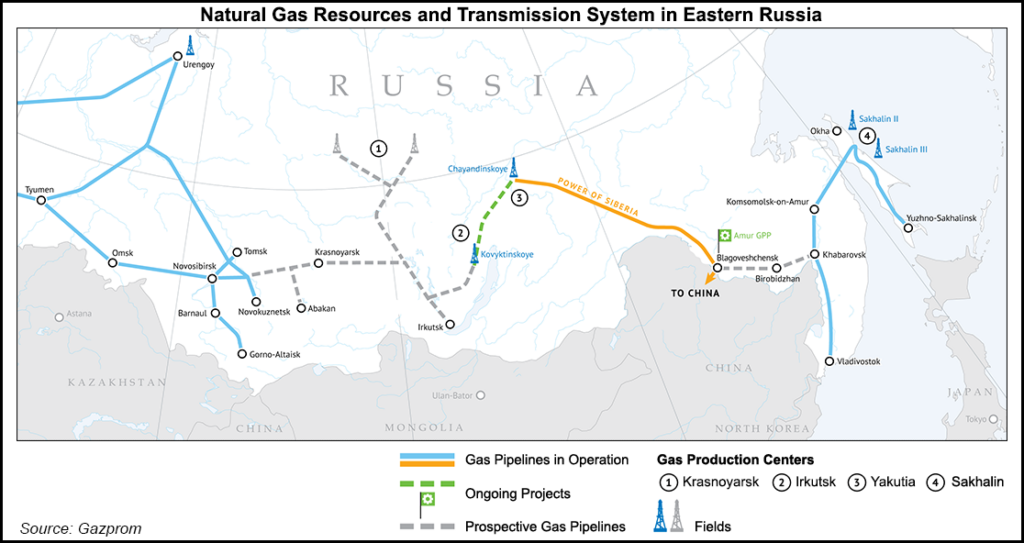Infrastructure | LNG | LNG Insight | NGI All News Access | NGI The Weekly Gas Market Report
Massive Russian Pipeline Enters Service, Further Dimming Outlook for U.S. LNG in China
Russia’s Gazprom on Monday said it has started moving natural gas on its massive Power of Siberia pipeline to China, one of the world’s largest importers of the fuel and where the U.S. is already at a disadvantage as a trade war with the country drags on.

Russia President Vladimir Putin was joined by China President Xi Jinping to hail the start of service on the system, solidifying Russia’s relationship with China, which has seen its ties with the West strained.
The massive trunkline will eventually be 3,000 kilometers long (nearly 1,900 miles) and have the capacity to move up to 38 Bcm (1.3 Tcf) of natural gas annually from the Chayandinskoye and Kovyktinskoye fields in Eastern Russia to Northern China, where supplies can link up with growing demand. Gazprom plans to start by moving about 350 MMcf/d before ramping to full capacity by 2025.
While the system will compete with LNG imports from leading suppliers such as Australia and Qatar, as well as other Russian volumes from Novatek on the Yamal peninsula, demand is forecast to be plentiful, especially as China continues to wean itself from coal while its economy grows.
China is the world’s second largest importer of LNG. Once a top destination for U.S. LNG exports, with about 65 cargoes shipped there since 2016 when exports started, American suppliers are at a disadvantage in the country. China has slapped tariffs on U.S. LNG imports as part of its trade dispute with the Trump administration. According to ClipperData, just two U.S. LNG cargoes have departed for China this year, both from Cheniere Energy Inc.’s Sabine Pass terminal.
The Power of Siberia is only likely to “further dampen the bearish sentiments in China,” said ClipperData’s Kaleem Asghar, director of LNG analytics. He told NGI that domestic production in the country along with regular LNG imports from other countries have also dimmed the outlook for the place of U.S. LNG in China.
Gazprom signed its largest contract ever with China National Petroleum Corp. in 2014 to supply the country for 30 years, underpinning the Power of Siberia project.
Gazprom has completed a 2,200 kilometer (1,300 mile) stretch of the system, which is now receiving volumes from the Chayandinskoye field. By 2022, the pipeline is also expected to receive supplies from Kovyktinskoye. An 800-kilometer (500 mile) stretch of pipeline will eventually be completed to connect both of the producing fields, Gazprom said.
LNG imports in China slid for the first time in three years during October, falling by 11.5% to roughly 4 million metric tons, according to China’s General Administration of Customs. Regas capacity has also been a limiting factor there, especially after PetroChina’s Rudong LNG import terminal was damaged in September when a vessel collided with a bridge.
© 2024 Natural Gas Intelligence. All rights reserved.
ISSN © 1532-1231 | ISSN © 2577-9877 | ISSN © 1532-1266 |
